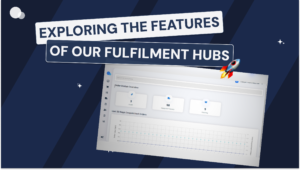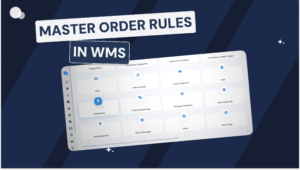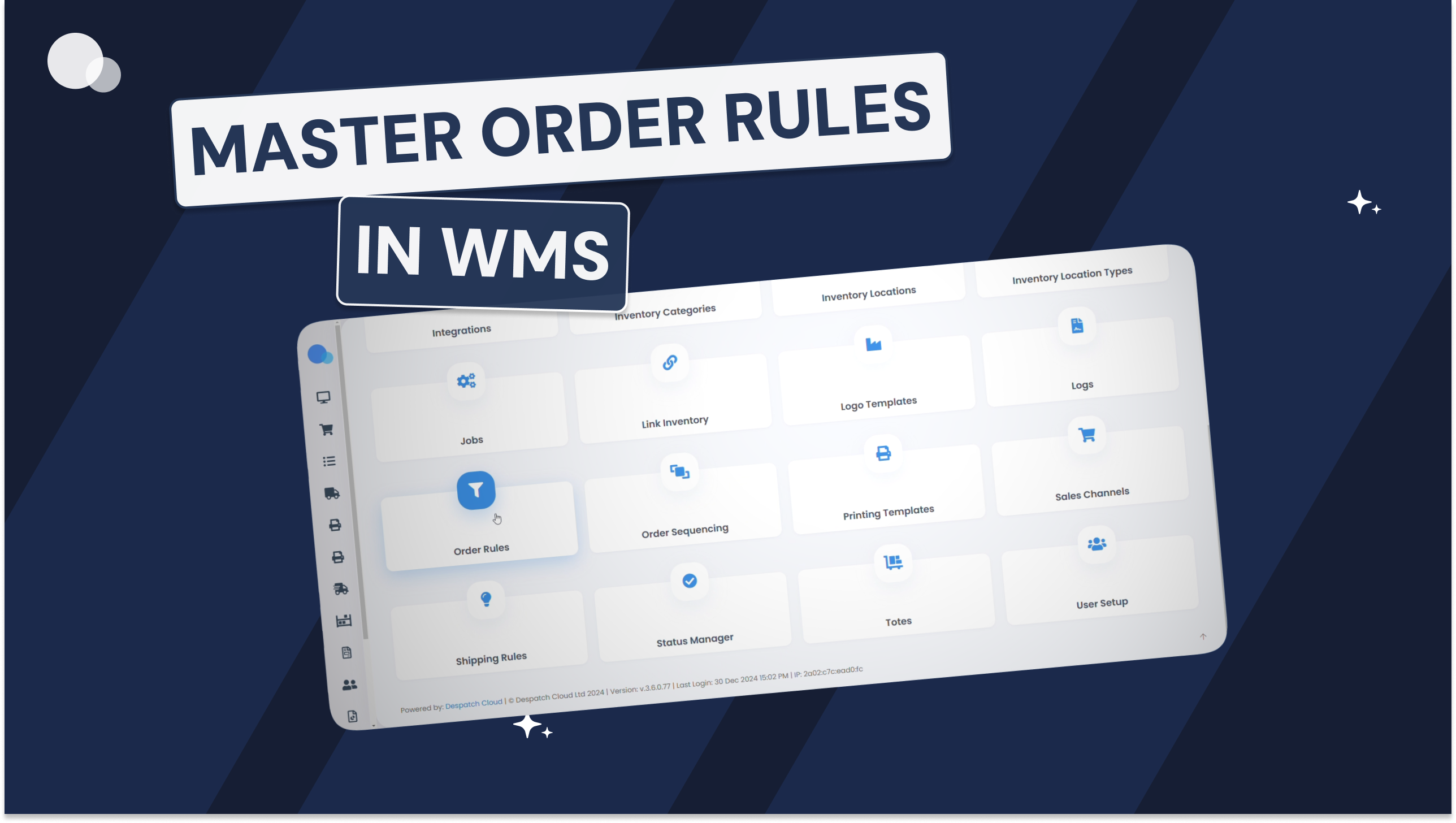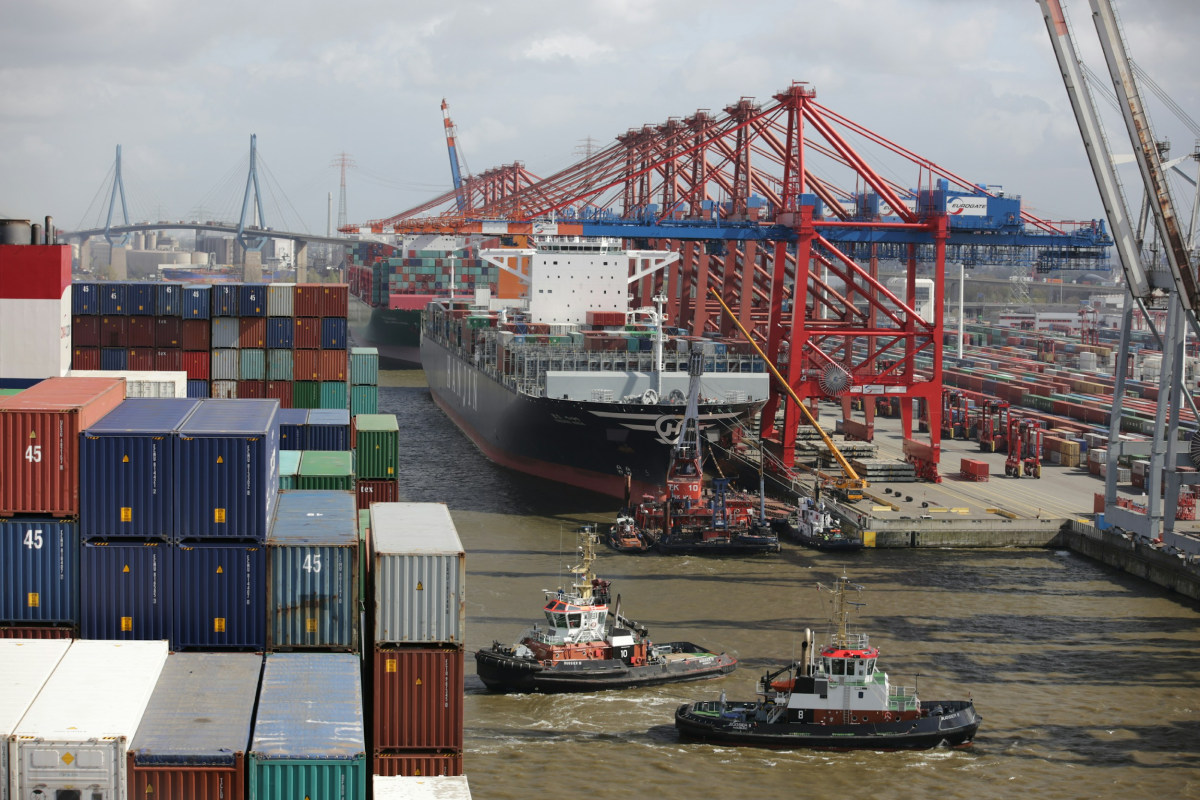These days customers want online deliveries almost as fast as when they shop in-store. You can’t let logistical hiccups slow your shipments. A 3PL warehouse management system (WMS) is a great solution to increase warehouse productivity and cut bottlenecks.
With a 3PL WMS, you get a comprehensive suite of tools to ensure you can run your warehouse in the most efficient way, providing inventory management, channel connectivity, shipping capabilities, milestone notifications and automating tasks.
Most importantly, a 3PL WMS like Despatch Cloud’s Fulfilment allows you to seamlessly work with your customers in one shared platform, providing them with a real-time view of their deliveries, stock levels and their orders. No longer will you be sinking in communications from customers asking for updates. By putting your customers in the driving seat you remove the guess work, giving them trust and transparency into your operation and ultimately, your business.
Like with any software, you need to do your research to ensure that you’re choosing the best 3PL software for your business. So, this article will highlight 9 key things to look for when selecting the right 3PL warehousing management tool. We’ll also cover what a 3PL typically entails and offer some vendor suggestions.
What is a 3PL Warehouse Management System?
A WMS is a software tool that lets you track your warehouse management tasks. Warehouse management software features may include:
- Inventory management
- Location management
- Order management
- Work creation and scheduling
- Process detailing for pick, pack, and ship
- Productivity reports and analytics
However, many traditional WMS tools are made for single warehouse operations and can’t handle 3PL. In comparison, 3PL warehouse management software is a WMS designed for 3PL fulfilment. It’s a much better software solution for enterprises with multiple warehouses.
While most 3PL warehouse software tools aren’t strikingly different from their traditional counterparts, a high-quality 3PL WMS system should offer the following capabilities:
3PL Billing
Whether you’re a 3PL business yourself or working with multiple providers, billing multiple entities gets complicated fast. Opt for a 3PL warehouse management software that can consolidate all your transactions into one report.
Transparent Inventory Tracking
Transparent inventory tracking is vital for 3PL businesses, especially when managing orders for multiple clients across various warehouses. Accurate stock levels are essential to ensure that orders are fulfilled efficiently and correctly. A robust 3PL warehouse management system (WMS) automates this process, providing real-time visibility into inventory across all locations. This not only ensures accuracy but also reduces administrative costs by eliminating manual tracking. Clients benefit from reliable order updates, while warehouses can make better-informed inventory decisions, leading to improved overall efficiency and customer satisfaction.
Order Fulfilment Features
Part of the reason why warehouses hire 3PL partners is to offload the burden of order fulfilment. Good 3PL warehouse management systems play this role for 3PL providers. They streamline order fulfilment procedures to cut tedious tasks down to size.
Multi-System Support
Your 3PL warehouse management tool should be able to integrate with everything your partners or providers use. If not, you may limit visibility and increase the siloing between the warehouse and the 3PL partner.
Before You Start Looking…
3PL management software solutions can simplify your day-to-day. Still, you should have a strategic plan that highlights your business goals and how (or if) a WMS will help you meet them.
Here are some questions you can ask yourself before you seek 3PL WMS vendors:
- What problems are you hoping to solve?
- What are you doing now that a WMS will improve?
- How many partners do you work with?
- What challenges do you foresee in the future?
- Does your business ship any specialty products that need extra regulation?
- What is your typical order volume? When are your peak seasons?
- How much work can your team handle manually?
- What is your budget? How can you get the best quality for your buck?
- Do you offer international shipping?
- How many users do you anticipate?
- How important is fast shipping to your business?
Once you’ve considered these questions, start shopping for vendors. The answers to these questions will help you narrow down a WMS shortlist and help you prioritise features.
Every WMS is different, but you should always watch for the following 9 features:
What to Look for in a 3PL Warehouse Manager Software
1. Scalability
When a business works with a third-party logistics partner, it’s likely because they’re too large to handle all their orders on their own. Once a company starts growing, they rarely slow down. So, opt for a 3PL logistics management software tool that can scale with rapid growth.
During the pandemic, many eCommerce companies experienced exponential growth, and this trend is continuing. It’s a good idea for eCommerce companies to prepare for rapid growth even if they haven’t experienced it yet. A 3PL partnership and scalable tool are ways they can prepare.
2. Automation
Backlogs happen fast when you’re dealing with a high volume of orders. Warehouse operators are quickly overwhelmed by sudden spikes, and this can slow down your order fulfilment. These backlogs are especially concerning during timely peak seasons like the holidays.
Prevent bottlenecks with a third-party logistics and warehouse software solution that has easy-to-use automation features. These features should let you quickly set rules about which orders are prioritised, and how they get boxed and shipped.
Use these rules to make sure presents arrive on time, food doesn’t expire en-route, and employees save time on fulfilment.
3. Online Capabilities
People may use your 3PL warehouse software on the road or from offsite locations. Your data needs to stay consistent for all viewers to prevent miscommunication. A cloud-based WMS solves this issue. Anyone with an internet connection sees the same data.
Consistency isn’t the only advantage of a web-based WMS. A cloud-based WMS is generally more scalable, secure, and has faster processing power. The cloud also makes your WMS run 24/7. This is perfect for eCommerce providers because online shoppers can order anytime.
During the pandemic, many eCommerce companies experienced exponential growth, and this trend is continuing. It’s a good idea for eCommerce companies to prepare for rapid growth even if they haven’t experienced it yet. A 3PL partnership and scalable tool are ways they can prepare.
4. Transportation Management
Some warehouse management tools also function as a transportation management system (TMS). A solution that can do both is particularly important for a 3PL system because 3PL companies need to keep a close eye on their logistics.
Transportation management optimises how your shipments move and ensures that truckers have the documentation they need to make a delivery. This system promotes timely deliveries and offers greater shipment transparency.
If you’re delivering across borders, this feature becomes even more important. Organize the necessary paperwork in your system so that drivers can access it in seconds, minimising the chance that they’ll get “stuck at the border.”
During the pandemic, many eCommerce companies experienced exponential growth, and this trend is continuing. It’s a good idea for eCommerce companies to prepare for rapid growth even if they haven’t experienced it yet. A 3PL partnership and scalable tool are ways they can prepare.
5. Current Technology
When a business works with a third-party logistics partner, it’s likely because they’re too large to handle all their orders on their own. Once a company starts growing, they rarely slow down. So, opt for a 3PL logistics management software tool that can scale with rapid growth.
During the pandemic, many eCommerce companies experienced exponential growth, and this trend is continuing. It’s a good idea for eCommerce companies to prepare for rapid growth even if they haven’t experienced it yet. A 3PL partnership and scalable tool are ways they can prepare.
6. Integrations
For the best results, seek a WMS that integrates with other tools you use. Many systems will automatically pull information from your other tools to streamline operations. Some useful integrations are:
- CRMs: Customer data from your CRM lets you track customer activity throughout your order fulfilment process.
- ERPs: Integrating your WMS with your ERP prevents data repetition and silos.
- TMSs: if you have a separate TMS, it’s crucial for your WMS users to be able to see TMS data.
- BI: Analytics from your WMS reporting should feed into your business intelligence (BI) tool to help your accounting team create consolidated reports. (For reference, business intelligence tools are a great way to collect data you’re able to tap into with inquiries.)
- eCommerce platforms: An eCommerce platform integration lets your WMS know that there’s a new order the moment a shopper makes a purchase.
You might also want to look for a system that can integrate with a custom in-house software tool. Anything that holds valuable information for your warehouse or 3PL partner should integrate with your WMS.
7. Label Compliance
Label compliance is essential for any company that offers international shipping. Improper labelling can cause unnecessary shipping costs at best and unfulfilled orders at worst.
A high-quality WMS tracks different label requirements for every country you ship to. Standardized labelling reduces the risk of human error and keeps you consistently in compliance.
8. User Friendliness
Don’t underestimate the importance of a user-friendly design. User-unfriendly WMS systems have less user adoption, hurt productivity, and even affect employee moral. If people are frustrated with your technology system, it can grow into frustration with your company.
Your WMS should make operations easier. Poor user design defeats this purpose and can be more inefficient than not having one at all. This is because finding workarounds can be more time-consuming than well-known manual processes.
9. Added Services
Warehouse management tools can also have additional unique features. These features fit well with niche businesses. You may or may not seek any of these added services. Depending on your business goals, you might want a 3PL warehouse management software that offers:
Specialty Materials Support
Some products like medicine, hazardous goods, or live animals need comparatively more attention. Regular tracking and compliance measures may not be sufficient for certain specialty products.
For example, if your products cannot be left unattended, you’ll need inventory tracking that also measures whether a worker is present. Label compliance may also differ for highly regulated products.
Kitting Features
Kitting is a great way to add a personal touch while streamlining product shipments. It’s ideal for companies that sell subscription boxes and boosts brand awareness.
WMS kitting functionality standardizes your warehouse’s kitting process. It makes it easy to consolidate multiple SKUs into one and may track which SKUs go well together.
Exception Management
Some WMSs have an exception management module. This module will flag atypical orders, so you know to give them extra attention or move them out of your processing lane. These situations could be due to weight, size, or a customer’s special request.
Support for High-Volume Returns
No business likes to think about order returns, but they happen, and you need to be ready for them. eCommerce businesses should prepare for a high volume of returns simply because of the number of orders they process. If you send a lot of shipments, make sure your WMS can handle a lot of returns.
What core features should you look for when choosing a 3PL Warehouse Management System?
Not all 3PL warehouse management systems are alike. At a minimum, your WMS should include:
- Inventory management, including the ability to segregate inventory by owner
- Packing, picking, and shipping functionality
- Reporting tools with individual client login and dashboards
- A dock door appointment scheduler, and shipping and receiving functionality
- Inventory control, including low inventory warnings and inventory transfer functionality
- Comprehensive warehouse management operations (including cycle counts)
- Ability to integrate seamlessly with other software and systems
- 3PL billing
- 3PL software scalability and customisation
Choosing the right WMS depends on various factors, like the size of your operation, the nature of your products, your budget, and the level of customisation you need.
Considering these key features will help you select the software that best aligns with your business needs.
Our top five 3PL Warehouse Management System picks
Despatch Cloud Fulfilment
Despatch Cloud Fulfilment is a WMS built with 3PL businesses and fulfilment providers in mind. It empowers with a master hub where you can manage all your warehouses, fulfilment orders and stock in one place. It also allows you to set up individual hubs for each of your fulfilment clients where they can check the status of their orders, purchase stock and access performance reports, just to name some.
Despatch Cloud Fulfilment integrates with 120+ couriers and 80+ marketplaces across the globe, offering a flexible and scalable solution for growing businesses. Its built-in billing solution also provides 3PL companies with a convenient and effective solution to invoicing their clients, with ability to automate charges for recurrent services, and fully customise the system to match their billing structure.
Key features:
- High-volume warehouse processing and multi-warehouse support
- Task management for efficient warehouse operations
- Master and client hubs for you and your fulfilment customers
- Smart stock alerts and automated purchase order suggestions
- Integration with a wide network of 150+ couriers, sales channels and marketplaces, as well as billing and accounting software
- Advanced analytics and reporting
SAP Extended Warehouse Management (EWM)
SAP EWM is a powerful third-party logistics WMS from the software vendor SAP. As part of SAP’s Supply Chain Management suite, it provides advanced warehouse management capabilities catering to the needs of complex 3PL organisations.
It provides flexibility in managing inventory in the warehouse and supports all warehouse activities, including inbound and outbound processing, warehouse structure, and more.
Key features:
- High-volume warehouse processing and complex supply chain logistics
- Labor management and demand planning
- Cross-docking and yard management
- Integration with other SAP modules and non-SAP software
- Advanced analytics and reporting
- Advanced analytics and reporting
Oracle Warehouse Management
Oracle Warehouse Management, a component of the Oracle E-Business Suite, is a robust solution offered by the software vendor Oracle.
It provides advanced warehousing, inventory management, and supply chain capabilities designed to support various business models, including third-party logistics companies. Its flexible architecture enables high levels of automation and customisation.
Key features
- Task management for efficient warehouse operations
- Inventory visibility and control across supply chains
- Automated data collection
- Support for multiple order fulfilment strategies
- Integration with other Oracle products
- Mobile capabilities for real-time data access
ShipBob
ShipBob is a modern eCommerce fulfilment platform from a renowned software vendor. The platform provides robust inventory management and order fulfilment capabilities, making it a great candidate for 3PLs.
Businesses can store inventory in ShipBob’s warehouses worldwide, reducing shipping costs and times. Furthermore, it integrates with popular ecommerce platforms and marketplaces.
Key features:
- Distributed inventory and order management
- Real-time analytics and reporting
- Returns management
- B2B and wholesale order fulfilment
- Batch and expedited order processing
- Integration with popular eCommerce platforms like Shopify, WooCommerce, and Amazon
ShipHero
ShipHero is a comprehensive, cloud-based 3PL warehouse management system known for its robust features that enable eCommerce businesses to manage their inventories efficiently.
This software stands out with its order management and batch-picking features, significantly reducing the time required to process orders.
Key features:
- Real-time inventory management
- Automated order routing and batch picking
- Customisable packing slips and labels
- Reporting and analytics tools
- Integration with various shopping carts, marketplaces, and carriers
- Mobile app for iOS for flexible operations
Final thoughts
3PLs serve their clients by providing warehouse services without the need for them to invest in expensive fulfilment facilities or logistics management.
To keep your customers satisfied and their businesses (and yours) growing, utilize the advantages of Despatch Clouds 3PL WMS software capabilities to streamline your business and increase your operation’s efficiency.






